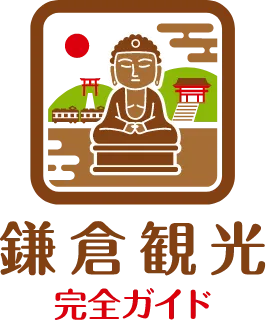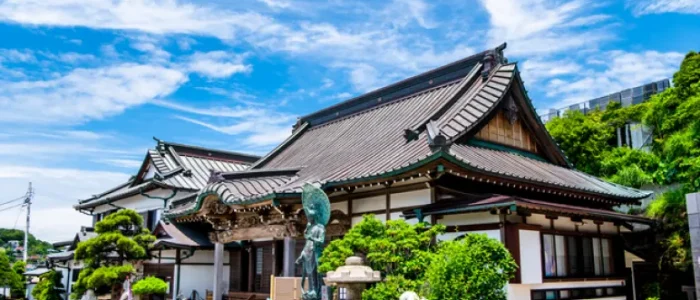Manpuku-ji Temple (満福寺)
What is Manpuku-ji Temple?|A Glimpse into Kamakura’s Ancient Spiritual Heritage
Nestled in the seaside district of Koshigoe, Kamakura, Manpuku-ji Temple dates back to the 8th century. It was founded during the Nara period when Buddhism was gaining recognition as a stabilizing force for the nation. According to tradition, the revered monk Gyōki conducted prayers here under imperial order to calm a local epidemic, leading to the temple’s establishment as a sacred place of healing and protection.
For over a millennium, Manpuku-ji has served not just as a place of worship but also as a quiet sanctuary where history and faith gently intertwine.
How is Manpuku-ji Connected to Yoshitsune?|Legends and Relics
The temple is most famously tied to the tragic tale of Minamoto no Yoshitsune, the heroic 12th-century samurai who defeated the Taira clan but was later exiled by his brother, Shogun Minamoto no Yoritomo. Barred from entering Kamakura, Yoshitsune stayed in Koshigoe and composed the poignant “Letter from Koshigoe” (Koshigoe-jō) here at Manpuku-ji, appealing for reconciliation.
Traces of his presence remain in the form of relics and spots:
- Koshikake Ishi (“Sitting Stone”): where Benkei, Yoshitsune’s loyal retainer, is said to have rested.
- Sumi no Ike (“Inkstone Pond”): believed to be the source of water for preparing ink.
- Tedama Ishi (“Stone of Strength”): a large rock Benkei is said to have lifted with ease.
Inside the temple, you’ll also find statues of Yoshitsune and Benkei, as well as folding screens featuring Kamakura-bori carvings that capture their emotional journey.
Hidden Cultural Meanings|Faith and Symbolism
At the heart of Manpuku-ji’s spiritual identity is the Yakushi Triad, enshrined as the main deity. The central figure, Yakushi Nyorai (Medicine Buddha), flanked by Nikkō and Gakkō Bodhisattvas, is revered for healing and restoring health. While normally kept hidden from view, the statues are occasionally revealed during special New Year ceremonies.
Another rare figure enshrined here is Uga-jin, a fusion of Shinto and Buddhist beliefs. This deity, depicted with the body of a serpent and an elderly human head, is associated with fertility, harvest, and financial luck—offering a glimpse into Japan’s syncretic spirituality.
Local Eats & Experiences|Legends, Crafts, and Soundless Crickets
Manpuku-ji is also home to some quirky lore: the story of Yoshitsune’s beloved flute, Usuzumi, is honored in memorial rituals for musicians and artists. There’s also the tale of Benkei scolding a cricket for disturbing his calligraphy—a legend that still explains why crickets fall silent near Sumi no Ike.
The temple also offers custom Goshuin (seal stamps) inspired by Yoshitsune’s legacy—an ideal memento for history lovers. Don’t miss the small on-site gallery featuring Kamakura carvings and historical displays that evoke the era’s ambiance.
Access & Morning Tips from Toshi’s Place|Walking Routes and Free-Time Exploration
Just a 5-minute walk from Koshigoe Station on the Enoden Line, Manpuku-ji is a perfect destination for a calm morning stroll or an afternoon break between sightseeing. If you’re staying at Toshi’s Place, the location is ideal—walkable from the guesthouse and easily reachable during early morning hours when the temple is at its quietest.
With flexible check-in and self-catering options, you can enjoy a slow breakfast or coffee in your room before heading out for a peaceful visit without crowds.
Temple Hours
8:00 AM – 5:00 PM (subject to change during special events)
Best Time to Visit|Seasonal Events and Serene Atmosphere
While Manpuku-ji offers tranquility year-round, spring is especially notable for the Yoshitsune Festival, held in connection with the larger Kamakura Matsuri. Expect historical reenactments and ceremonial rites that bring the samurai’s legacy to life.
Year-end also offers a rare chance to see the Yakushi statues during the New Year’s opening. The early morning is best for quiet reflection, and staying nearby means you can take full advantage of these moments.
Hidden Gems Around Koshigoe|Coastal Town Walks and Fresh Seafood
The Koshigoe area is a charming blend of ocean breeze and local flavor. Visit Koshigoe Harbor, stroll along Koshigoe Beach, or try freshly caught seafood at cozy family-run eateries.
From here, Enoden trains make it easy to explore Enoshima, Hase, and Yuigahama, making Manpuku-ji an excellent waypoint on your Kamakura itinerary.
Final Thoughts|A Place Where History Speaks Softly
Manpuku-ji is more than a temple—it’s a doorway to a different time. The stillness of the grounds, combined with the powerful story of Yoshitsune, invites visitors to reflect, slow down, and reconnect with Japan’s spiritual and historical roots.
Whether you’re on a samurai pilgrimage or simply seeking peace, this quiet gem in Koshigoe offers something uniquely profound—especially when explored at your own pace.

